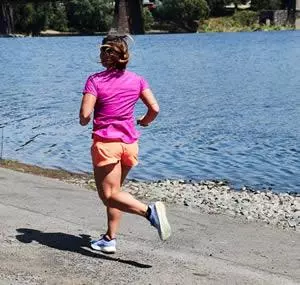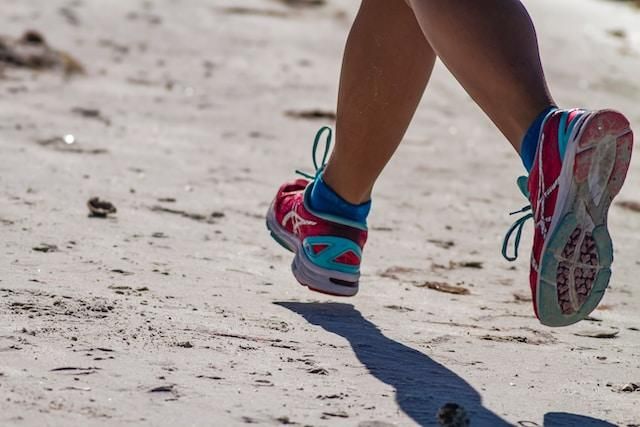Alphabetical Index of Articles on Women's Sexual, Pelvic Floor, and Reproductive Health
7 Tips for Returning to Running Postpartum

Are You Thinking of Returning to Running Postpartum?
There is not a magic time frame as each person recovers differently and the most important thing is to listen to your body.
For healthy uncomplicated pregnancies and deliveries the American College of Obstetricians and Gynecologists (ACOG) recommends women return to low-moderate intensity exercise at six weeks postpartum and eight weeks postpartum for cesarean.
After your OBGYN or midwife has cleared you to return to exercise, if you haven’t started with a Pelvic Floor Physical Therapist yet, now is a good time.
Blog: A Safe Return to Running and Impact Activities in Postpartum

During pregnancy, the body goes through tremendous changes that can significantly impact strength, endurance, and ability to absorb ground reaction forces that are required to safely return to running. Your growing belly changes your posture, your hormones are making your joints more flexible, and some amount of deconditioning is expected and normal as pregnancy progresses.
For most postpartum runners, their return to running following birth can be intimidating and overwhelming.
Female Athlete Triad – The Distance Runner’s Hidden Obstacle

If you’ve trained for a marathon or half marathon, you’re well acquainted with the dangers of shin splints, pulled muscles, and joint injuries.
And you probably take deliberate care to avoid them.
But it may surprise you to learn female distance runners face a little-known health risk that can have serious, even permanent, consequences.
I’m talking about Female Athlete Triad (FAT).
A recent article in the Journal Of Women’s Health Physical Therapy defines the condition by its three components: “low energy availability, menstrual dysfunction, and low bone density”. Those components form a chain reaction of problems that build on each other. Unchecked, each one can lead to long-term health issues from hormonal imbalance to lowered metabolism and immunities, to osteoporosis. But it’s easily ignored by those who suffer from it, and misdiagnosed by their doctors.
How Is Your Running Changed After Childbirth?

What studies say about returning to running as postpartum exercise
Most of the therapists in our office are moms, and we intimately understand wanting to get back to exercise after delivery. Caution should be taken when returning to running postpartum - we see this clinically and research also shows postpartum movement strategy changes that can increase your risk of injury.
A recent pilot study by Provenzano et al., 2019 compared the biomechanical changes of runners pre-pregnancy (or <14 weeks gestation and postpartum). They found at six weeks postpartum subjects had decreased trunk and pelvic rotation, decreased running speed, with increased step width and stance time compared to pre pregnancy measurements. They also found decreased motion in the hips with increased motion at the knee as a compensation.
Kasia's Road to The Boston Marathon Part 1: A Tribute to Its First Female Runners

Road to Boston Marathon Part 1
A Tribute to the First Female Runners
On April 18, 2022 I am excited and grateful to be able to run the historic and prestigious Boston Marathon! As a physical therapist at Fusion Wellness /Femina Physical Therapy and avid long-distance runner for over 20 years, I’m excited to share my training journey with you leading up to the race. This race holds a special place in the hearts of long-distance runners because you must run a qualifying race with a qualifying time. Females ages 18-34 must run 3 hours 30 minutes or better, and males ages 18-34 must run 3 hours flat or better.
Runner's World Asks Heather Jeffcoat About Symptoms of a Weak Pelvic Floor
 As they mention on their website, Runner’s World provides inspirational tales from the trail, race advice, and more. When Laura Williams Bustos, M.S. wanted to learn more about the connection between running and a healthy pelvic floor, I was glad to offer my insights as a licensed Physical Therapist. Here are some excerpts from the article interspersed with my own commentary, along with a link to the full article at their website.
As they mention on their website, Runner’s World provides inspirational tales from the trail, race advice, and more. When Laura Williams Bustos, M.S. wanted to learn more about the connection between running and a healthy pelvic floor, I was glad to offer my insights as a licensed Physical Therapist. Here are some excerpts from the article interspersed with my own commentary, along with a link to the full article at their website.
Heather Jeffcoat, DPT3 Surprising Symptoms of a Weak Pelvic Floor
Experts explain why a strong pelvic floor is so important for runners, plus what to look for to make sure your muscles can withstand mileage.
Few things demand as much of your pelvic floor as running, and whether you run competitively or just to stay in shape, having a strong and healthy pelvic floor will make your running routine both more beneficial and more enjoyable.
Running Mechanics and Pelvic Floor Health: The Impact of Footwear

Did You Know That Proper Footwear Can Improve Your Running Mechanics and Pelvic Floor Health?
How Do My Feet Impact My Pelvic Floor When I Run?
If you are a runner, you tend to look for ways to improve your running. If you’re thinking about starting up or returning to running, it can feel intimidating particularly if you have any symptoms related to pelvic floor dysfunction. This only complicates an exercise that, on the surface, seems fairly straight forward. There are some studies that have looked at how your feet can play a part in your pelvic floor muscle function while you run. And if you are looking to return to running postpartum, read on and also check out this article by one of our pelvic floor physical therapists.












